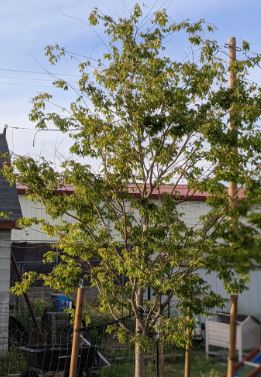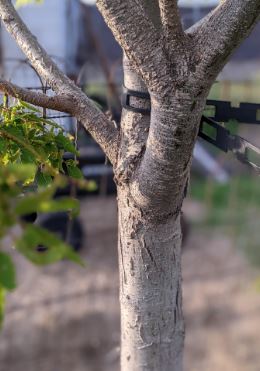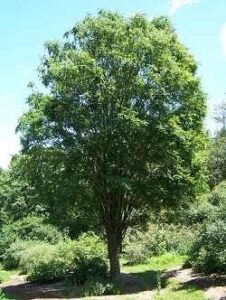Due to its remarkable look and flexibility, the Japanese zelkova tree is a popular landscaping option worldwide. This tree offers shade, beauty, and environmental advantages. However, like all trees, the Zelkova comes with its own set of advantages and disadvantages. In this blog post, we will explore the pros and cons of planting a Zelkova tree in your yard.
The Zelkova, a vase-shaped tree native to the Far East, boasts fast growth, adaptability, and vibrant fall colors. Resistant to Dutch elm disease, it requires a sizable backyard due to its expansive growth. With attractive leaves transitioning from green to golden and rust in fall, complemented by an appealing trunk that exposes orange-brown inner bark as it ages, the Zelkova offers a stunning and resilient addition to landscapes.
| Pros of Zelkova Trees | Cons of Zelkova Trees |
|---|---|
| Excellent at Shading | Japanese Beetles Attracted to the Leaves |
| Offers Good Cleanup | Dieback in Colder Areas |
| Convenient to Handle | |
| Widely Used for Bonsai | |
| Resistance to Dutch Elm Disease |
Pro: Excellent at Shading
Large shade trees like the Japanese zelkova are often disregarded, yet they make wonderful choices for planting in yards and along streets. This tree provides copious amounts of shade and has a wide crown comparable to elm trees. Depending on the variety, the leaves of the Japanese zelkova change to a lovely shade of yellow, red, or purple in the autumn.
Japanese zelkova is quite simple to grow. It is a sturdy tree that can withstand cold weather, doubles as an ornamental and a shade tree, and is resistant to Dutch elm disease, making it a suitable substitute for American elm. The tree has a robust root system and is tolerant to urban environments. It thrives in full sun or light shade, well-drained, wet, rich soil.
Water Japanese zelkova once a week, deeply, and completely. Maintaining the tree’s form, removing damaged or dead branches, and enhancing its general health all depend on pruning. Insecticidal soaps or horticultural oils may be used to treat pests including spider mites, aphids, and scale insects that affect Japanese zelkova.
The “Green Vase” tree, a well-liked type of Japanese zelkova, with a canopy in the form of a vase that is excellent for small yards and parkways. This type is simple to cultivate and provides year-round interest in the landscape. The Green Vase is a well-liked option for anyone searching for a tree that will produce shade soon since it grows more swiftly than other types of Japanese zelkova.

Pro: Offers Good Cleanup
For those looking for a tree that won’t create a mess, the Zelkova tree is a fantastic option since it is simple to clean up in the autumn.
The Japanese Zelkova tree is very tolerant of a broad variety of climatic circumstances, which is one of its most intriguing characteristics. It is the perfect tree for anyone looking for a low-maintenance addition to their yard or garden since it is drought and air pollution resistant and can thrive in a range of soil types. The Zelkova tree has numerous advantages, but it isn’t as widely cultivated as it may be. This is probably because people aren’t aware of them.
The Zelkova tree’s visual attractiveness is another benefit. It is a well-liked option for lawns and parks because to its appealing bark and leaf color and vase-like form. It is also an excellent street tree, which means it may be planted beside roadsides to provide shade and raise the area’s aesthetic value.
The ecological importance of the Zelkova tree is also well known. It provides nice shade, is simple to clean up after in the autumn, and can withstand heat, drought, wind, and urban environments. It is the best option for anyone who wish to plant a tree that will benefit their neighborhood’s ecosystem.
There are other Zelkova tree kinds available, such as the Musashino Japanese Zelkova, which has a lovely columnar structure with thin, medium-green leaves with serrations. The Musashino Japanese Zelkova is an excellent option for anyone looking for a tree that is both beautiful and simple to maintain. It thrives in wet, well-drained soil.

Pro: Convenient to Handle
The zelkova tree’s ease of handling is one of its key features. The tree may be carried in a burlap form and is simple to transplant. It is a low-maintenance tree since it is resistant to Dutch Elm disease and insect infestations.
The zelkova is aesthetically pleasing because of its vase-shaped crown, which is reminiscent of an adult American Elm. In the fall, the green leaves change to yellow, copper, or red, creating a stunning display of autumnal hues.
The medium-sized Japanese zelkova is a member of the same family as the elm tree and is a deciduous tree. Due to its beautiful design, lush foliage, appealing bark, and capacity for shade, it is a well-liked option among gardeners and landscapers. In order to prevent exposure to frost and take advantage of the tree’s slow growth rate of 1 to 2 feet each year, planting a young zelkova in the spring is advised.
The ideal circumstances are crucial for the growth of a healthy zelkova. Zelkovas can tolerate little shade but prefer the full sun. They may grow in a wide range of soil types, but they thrive in wet, well-drained soil. Overwatering the tree should be avoided as it might cause root rot.
The zelkova may benefit from fertilization in the early spring and mid-summer. Use a balanced fertilizer and apply it as directed by the manufacturer. Additionally, pruning is required to maintain the tree’s form and get rid of any branches that are sick, damaged, or dead. The zelkova should ideally be pruned in the winter, when it is dormant.

Pro: Widely Used for Bonsai
Zelkova serrata is a well-liked plant for bonsai growth because of its lovely, smooth, broadleaf foliage that is pointed and serrated. Although it has a 100-foot maximum height, it is often cut and trained to be a smaller bonsai tree.
Zelkova is a well-liked substitute for American elm because of its reputation for resistance to Dutch elm disease. The Japanese grey-bark elm, or Zelkova serrata, is the species used for bonsai the most often. However, bonsai may be made from any Zelkova species with smaller leaves.
There are a few considerations to make if you want to develop a Zelkova bonsai. First and foremost, it’s crucial to provide the tree the right attention, which includes routine watering, fertilizing, and trimming. Second, based on your preferences and the environment, Zelkova bonsai trees may be cultivated either inside or outdoors. Finally, it’s crucial to remember that the Zelkova bonsai tree grows quickly, so periodic trimming may be necessary to keep it in form.
The following advice will help you take care of your Japanese elm bonsai tree:
- Zelkova bonsai plants need frequent watering since they enjoy damp soil. Do not, however, overwater them since this might result in root rot. The amount of watering required will vary depending on the climate, size of the pot, and kind of soil.
- During the growth season, it is crucial to fertilize your Zelkova bonsai tree. Every two weeks, use a balanced fertilizer that has been diluted to half strength.
- Zelkova bonsai trees must be regularly pruned in order to keep their size and form. During the winter months, prune the branches, and in the spring, pinch back the new growth.
- Repotting: To sustain their health and development, zelkova bonsai trees should be replanted every two to three years. Early in the spring, before new growth develops, repotte.
Pro: Resistance to Dutch Elm Disease
The Japanese Zelkova tree, a member of the Ulmaceae family of elms, is a desirable substitute for the American elm due to its resistance to Dutch elm disease.
The Japanese Zelkova tree’s resistance to Dutch elm disease, which has killed millions of American elms in the US, is one of its key benefits. The Japanese Zelkova tree is also resistant to the Japanese beetle and elm leaf beetle. Transplanting should be done in the spring since young trees are vulnerable to frost.
The Japanese Zelkova tree grows in a vase-like shape and, with appropriate trimming, has a sturdy framework. To promote new growth in the spring, pruning should be done in the autumn. Pruning is necessary for Japanese Zelkova trees to establish a sturdy structure and stop weak branches from growing.
This tree is suitable for use as a street tree and does well in urban environments. It has lovely green foliage in the summer that change to yellow, orange, or reddish-purple in the autumn. Small, unassuming blooms appear in the spring, and are followed by winged fruits that ripen in the autumn.
Con: Japanese Beetles Attracted to the Leaves
Zelkova trees are vulnerable to serious threats from Japanese beetles because they feed on their leaves, blooms, tree and shrub buds, and fruit. These bugs consume the soft tissue in between the veins of leaves, leaving the foliage lace-like and skeletonized. After being eaten by bugs, flower petals become ragged.
There are various methods you may take to safeguard your Zelkova trees against Japanese beetles. Japanese beetles may be eliminated quickly and easily by being hand-picked and dropped into a pail of soapy water. You may also employ Japanese beetle traps, which utilize pheromones to attract and capture insects. The traps must be set at least 30 feet away from your Zelkova trees, however, since they may end up luring additional insects into your property.
Utilizing chemical or natural repellents is another efficient way to ward off Japanese beetles. You may create your own spray by combining one gallon of water with one cup of vegetable oil and one tablespoon of dish soap. As an alternative, you might buy pesticides made particularly to eradicate Japanese beetles. It is crucial to thoroughly read and adhere to the label directions before applying any pesticide.
You may also grow trap crops, or plants that entice pests away from your primary crop, to keep Japanese beetles from invading your Zelkova trees. Roses, trees with crimson leaves, and fruit trees are a few flora that are known to attract Japanese beetles. You may lessen the amount of insects attracted to your Zelkova trees by planting these trap crops.
Read our article on 12 Common problems in Zelkova trees.
Con: Dieback in Colder Areas
While not as cold-hardy as the latter, the Japanese Zelkova is thought to be more consistently cold-hardy than other cultivars, making it a preferred shade tree replacement for the disease-ravaged American elm. The Japanese Zelkova can endure mild heat, however its optimal USDA zones range from 5 to 8.
The Japanese Zelkova is susceptible to a number of issues, including twig and leaf die-back caused by a lack of cold tolerance, which may happen in colder climates. In areas with continental temperatures, early fall cold snaps may be the cause of this die-back. Before trying to remedy the die-back, it is crucial to correctly identify the source since this issue might potentially be brought on by a wooly elm aphid or a phytophthora disease organism.
A Japanese Zelkova has to be fertilized and watered correctly throughout the winter months in order to survive. Although dormant plants can withstand extremely low temperatures, when they are young, late spring frosts may occasionally harm them. The tree should get any necessary irrigation over the winter to maintain moist but not too soggy soil. Given that the tree can handle a variety of soil types, it is crucial to supply moderate to regular quantities of water throughout the summer.
Pruning may be crucial for preserving a Japanese Zelkova’s health. Before the tree starts to leaf out, it is advised to trim the tree in late winter or early spring. This will enhance the tree’s general health and attractiveness by encouraging new growth.
I hope you find the information about “Zelkova Tree Pros and Cons” helpful. As you know, Zelkova trees are flexible and attractive yard additions. Its attractive leaf, bark, and adaptability make it a popular landscaping option. It’s crucial to know that Zelkova trees are susceptible to pests and diseases and have invasive roots. A Zelkova may be a beautiful and important addition to any outdoor area if you weigh the advantages and drawbacks and properly care for it.
Related Posts:
